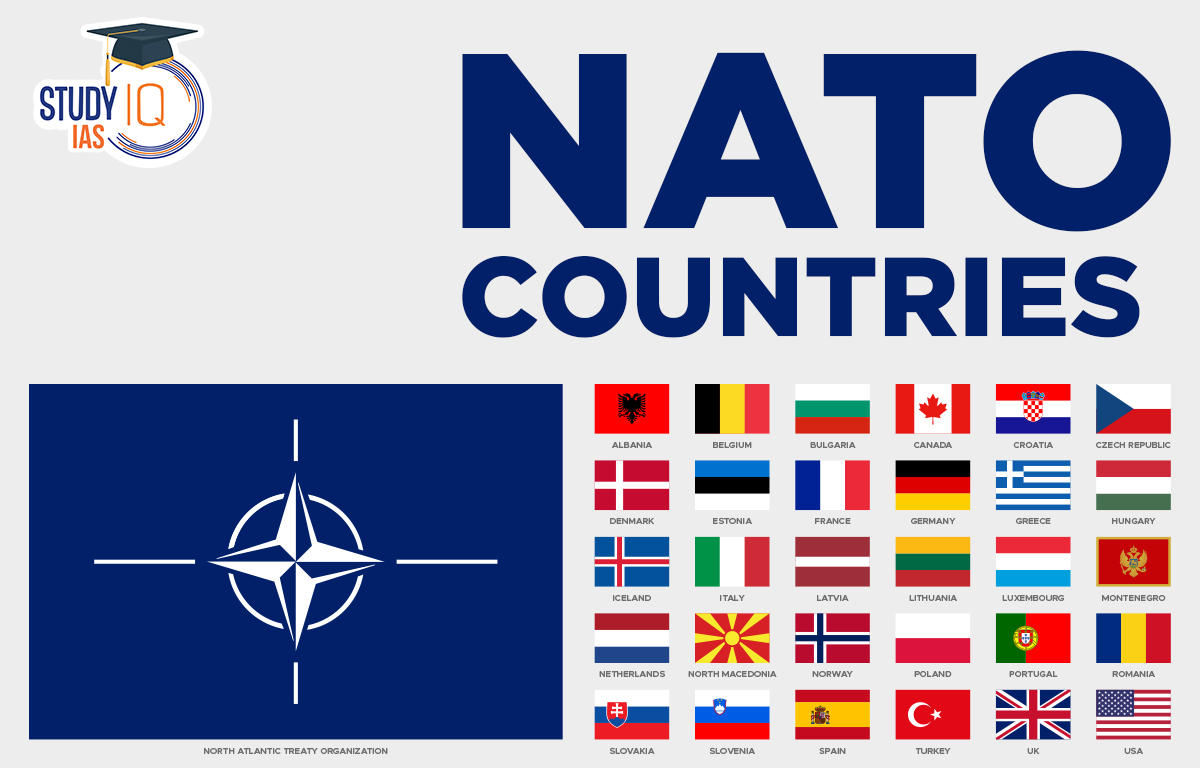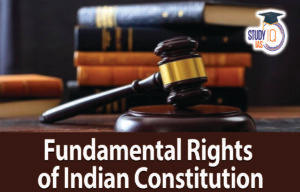Table of Contents
NATO Countries List 2024
North Atlantic Treaty Organization, or NATO, celebrated its 75th anniversary on April 4, 2024. This marks a significant milestone for the military alliance that was formed in the wake of World War II. Since its establishment on April 4, 1949, the Transatlantic Alliance has expanded from 12 initial members to encompass 32 member nations, united in their collaborative efforts to ensure the safety of their citizens.
Sweden is set to officially join NATO after Hungary finally gave its approval, the last member of the Western alliance to ratify the bid. Read this article to get information about the NATO Countries List 2024, its Purpose, Functions, Members and many more.
What is NATO?
The North Atlantic Treaty Organization (NATO) is an intergovernmental military alliance of 32 member states based in Europe and North America. The organisation was founded in the aftermath of World War II to counter the threat posed by the Soviet Union and to promote democracy and stability in Europe. The founding treaty of NATO, the North Atlantic Treaty, was signed in Washington, D.C. on April 4, 1949.
NATO Full Form
NATO is the abbreviation of the North Atlantic Treaty Organization. The main objective of NATO is to protect the independence and security of the Allies via political and military action.
NATO Members 2024
NATO continues to be the transatlantic community’s major security tool and a representation of its shared democratic values. It serves as a realistic link that binds North American and European security together indefinitely. NATO enlargement has furthered the U.S. vision of a Europe whole, free, and at peace. North Atlantic Treaty Organization (NATO) countries list 2024 consists of 32 countries, of which 12 founder Countries joined the list in 1949, and 19 other countries then joined the list one by one.

NATO Countries List 2024
You can check here the List of NATO Member Countries 2024 with its capital city.
| NATO Countries List 2024 | |
| NATO Country | Capital City |
| Albania | Tirana |
| Belgium | Brussels |
| Bulgaria | Sofia |
| Canada | Ottawa |
| Croatia | Zagreb |
| Czechia | Prague |
| Denmark | Copenhagen |
| Estonia | Tallinn |
| Finland | Helsinki |
| France | Paris |
| Germany | Berlin |
| Greece | Athens |
| Hungary | Budapest |
| Iceland | Reykjavik |
| Italy | Rome |
| Latvia | Riga |
| Lithuania | Vilnius |
| Luxembourg | Luxembourg |
| Montenegro | Podgorica |
| Netherlands | Amsterdam |
| North Macedonia | Skopje |
| Norway | Oslo |
| Poland | Warsaw |
| Portugal | Lisbon |
| Romania | Bucharest |
| Slovakia | Bratislava |
| Slovenia | Ljubljana |
| Spain | Madrid |
| Sweden | Stockholm |
| Turkiye | Ankara |
| The United Kingdom | London |
| The United States | Washington D.C. |
Read More: BIMSTEC Countries
NATO Countries Map

We’re now on WhatsApp. Click to Join
NATO Purpose and Objectives
Political
NATO encourages democratic principles and allows its members to consult and work together on defence and security-related matters to solve disputes, foster trust, and, ultimately, minimize conflict.
Military
NATO is committed to the peaceful resolution of disputes. If diplomatic efforts fail, it has the military power to undertake crisis-management operations. These are carried out under the collective defence clause of NATO’s founding treaty – Article 5 of the Washington Treaty or under a United Nations mandate, alone or in cooperation with other countries and international organisations.
Collective Defence
NATO is dedicated to the idea that an attack on one or more of its members constitutes an attack on all of them. This is the collective defence principle, which is outlined in Washington Treaty Article 5 of the agreement. In reaction to the 9/11 terrorist attacks in the United States in 2001, Article 5 has only been used once so far.
Transatlantic Link
North American and European countries are members of NATO. It creates a special connection between these two continents, allowing them to consult, work together on security and defence issues, and coordinate international crisis management activities.
Population of NATO Countries
At present in 2024, the NATO alliance encompasses 32 member countries, collectively representing a population of around 952.7 million people. These nations, united under the North Atlantic Treaty Organization, span diverse regions and demographics, contributing to the alliance’s strength and cooperative efforts.
With a shared commitment to mutual defense and cooperation, the member states of NATO collectively strive to address global security challenges, fostering stability and collaboration on an international scale. The alliance’s extensive population reflects the diverse backgrounds, cultures, and contributions of its member nations, reinforcing the collaborative and interconnected nature of the NATO community.
NATO Countries Bordering Russia
The length of the border between NATO countries and Russia is approximately 2,300 miles (3,700 kilometers). The border between Norway and Russia is the longest, at over 1,200 miles (1,900 kilometers). The border between Azerbaijan and Russia is the shortest, at just over 20 miles (30 kilometers). As of February 2024, NATO 14 countries border Russia:
- Norway
- Finland
- Estonia
- Latvia
- Lithuania
- Poland
- Belarus
- Ukraine
- Romania
- Bulgaria
- Turkey
- Georgia
- Armenia
- Azerbaijan
NATO Countries Bordering Ukraine
The NATO countries bordering Ukraine are playing a critical role in the ongoing conflict. They are helping to protect Ukraine from further Russian aggression and are working to bring about a peaceful resolution to the crisis. Here are the Countries bordering Ukraine:
- Poland
- Romania
- Slovakia
Founder Countries of NATO Alliance
The founding treaty of NATO, the North Atlantic Treaty, was signed in Washington, D.C. on April 4, 1949. The original 12 members of NATO were Belgium, Canada, Denmark, France, Iceland, Italy, Luxembourg, the Netherlands, Norway, Portugal, the United Kingdom, and the United States.
How Does NATO Functions?
NATO Decision-Making Bodies
- North Atlantic Council (NAC)
- The supreme decision-making body of NATO.
- Composed of the ambassadors of all NATO members.
- Meets at least once a week.
- Makes decisions on all matters relating to the security of the alliance.
- Military Committee
- The highest military authority of NATO.
- Composed of the chiefs of defence of all NATO members.
- Meets at least twice a year.
- Provides military advice to the NAC and is responsible for the planning and conduct of NATO operations.
NATO Decision-Making Process
- NATO functions through a system of consensus decision-making.
- This means that all NATO members must agree on any decision before it can be implemented.
- This ensures that all members have a say in the decisions that affect them and that no one member can dominate the alliance.
NATO Burden-Sharing
- NATO also functions through a system of burden-sharing.
- This means that all NATO members are expected to contribute to the alliance’s common defence.
- This includes contributing troops, equipment, and money. NATO members spent over $1 trillion on defence in 2022, with the US accounting for 70%, up from 50% during the Cold War.
- The amount of burden-sharing that each member contributes is based on its ability to pay and its strategic importance to the alliance.
Read about: International Organizations and their Headquarters
Finland Joined NATO
Finland officially became the 31st member of the North Atlantic Treaty Organization (NATO), marking a major shift in the security landscape in northeastern Europe.
Implications of Finland Joining NATO
- Enhanced security for Finland: Finland shares an 832-mile border with Russia. Adding Finland to NATO will more than double the size of NATO’s border with Russia, and it will double security on the border.
- Impact on Russia: NATO’s expansion threatens Russia’s sphere of influence. This could lead to a further deterioration of relations between Russia and the West, potentially escalating regional conflicts and creating new geopolitical fault lines.
- Changing the balance of power: Finland’s membership in NATO could strengthen the alliance’s position in the Baltic Sea region and potentially alter the balance of power vis-à-vis Russia.
- Impact on Arctic region’s geopolitics: Finland joining NATO adds real military capability to the Western alliance in the Nordic region, potentially impacting the Arctic region’s geopolitics and commercial attractiveness, and making global governance of the Arctic region increasingly problematic. India is an observer of the Arctic Council that seeks to promote wide-ranging cooperation in the polar north.
NATO Expansion
The Soviet Union responded to NATO by creating its own military alliance with seven other Eastern European communist states in 1955, dubbed the Warsaw Pact. But after the collapse of the Soviet Union in 1991, several former Warsaw Pact countries became NATO members. This includes Hungary, Poland, Bulgaria, Estonia, and Latvia among others. The most recent additions were North Macedonia in 2020 and Finland in 2023 and then Sweden in 2024, bringing the total number of NATO member states to 32.
Major Non-NATO Ally Status
Non-NATO Ally Status is a designation given by the US government to close allies that have strategic working relationships with the US Armed Forces but are not members of NATO. The US has designated 30 other countries including Japan, South Korea, Japan, Israel etc. as major non-NATO allies. The status confers a variety of military and financial advantages such as participation in defence research projects and counter-terrorism initiatives, buying depleted uranium ammunition etc. that otherwise are not obtainable by non-NATO countries.
Read about: Countries and Capitals
NATO Membership Requirements
Minimum Requirements for Acquiring NATO Membership
Article 10 of the North Atlantic Treaty prescribes the following as requirements for joining NATO as a member:
- New members must uphold democracy, including tolerating diversity.
- New members must be making progress toward a market economy.
- Their military forces must be under firm civilian control.
- They must be good neighbours and respect sovereignty outside their borders.
- They must be working toward compatibility with NATO forces.
Procedure for Acquiring Membership
NATO membership normally involves a long process, and it requires unanimous approval, which equals the approval of all 32 existing allied countries.
Benefits of Acquiring NATO Membership for a Country
- Security: NATO provides a collective defence system that can deter potential threats and protect member countries from aggression.
- Enhanced Military Capabilities: NATO membership offers access to advanced military technology, training, and joint exercises with other member countries, which enhances a country’s military capabilities and readiness.
- Political Influence: Being a NATO member can provide a country with a stronger voice on the international stage and a greater say in global security and defence matters.
NATO Countries Partnerships
NATO collaborates with 40 non-member countries on a variety of political and security-related matters. Many of these countries participate in operations and missions that are headed by NATO and actively pursue communication and practical cooperation with the Alliance. Additionally, NATO collaborates with a wide range of international organisations. Partner countries do not have the same power to make decisions as members.
NATO’s ‘Collective Defense Mechanism
Collective defence means that an attack against one Ally is considered as an attack against all Allies. The collective defence principle is at the heart of NATO’s founding treaty. It is enshrined in Article 5 of the Washington Treaty.
NATO’s ‘Collective Defense Mechanism Examples
NATO invoked Article 5 for the first time in its history after the 9/11 terrorist attacks against the United States. NATO has taken collective defence measures on several occasions, including in response to the situation in Syria and the Russian invasion of Ukraine.
Standing Forces of NATO
NATO has a number of standing forces on active duty that contribute to the Alliance’s collective defence on a permanent basis. These include NATO’s four standing maritime group fleets, which are ready to act when called upon. Additionally, NATO has an integrated air defence system that links national air defence capabilities together and includes the Alliance’s ballistic missile defence capabilities.
Troops and Equipment
When the Alliance collectively decides to conduct an operation, it asks the Allies for troops and equipment to be placed under NATO command.
Is Israel a Member of NATO?
Israel is not a member of NATO (North Atlantic Treaty Organization). Israel has a unique geopolitical status in the Middle East, and its relationship with NATO is not that of a member state. As of 2024, NATO consists of 32 sovereign member countries. Despite not being part of these member nations, Israel’s designation as a major non-NATO ally underscores its substantial role within the alliance’s structure. While Israel maintains diplomatic and military ties with various countries, including some NATO member states, it is not a participant in the alliance. NATO’s membership is limited to North American and European countries that have joined the organization through the signing of the North Atlantic Treaty.
Read more:- Israel-Hamas War
NATO and India
India’s Engagement with NATO is explained below in detail:
Ballistic Missile Defence (BMD)
In September 2011, NATO invited India to be a partner in its BMD system. This was the first time that India was invited to participate in a NATO initiative. However, India did not accept the invitation and expressed concerns over its impact on India’s strategic autonomy and its relations with other countries, particularly Russia.
First Political Dialogue
New Delhi held its first political dialogue with the North Atlantic Treaty Organisation (NATO) in Brussels on December 12, 2019. The significance of this dialogue includes:
- Strengthening diplomatic ties: The talks signify India’s efforts to strengthen its diplomatic ties with NATO, which is a crucial security alliance in the Euro-Atlantic region.
- Countering China and Pakistan: The talks hold significance given that NATO has been engaging both China and Pakistan in bilateral dialogue. India’s engagement with NATO can help counterbalance China and Pakistan’s influence in the alliance.
- Balance in NATO’s perception: Engaging NATO in a political dialogue would provide India with an opportunity to bring about a balance in NATO’s perceptions about the situation in regions and issues of concern to India.
Perspective on Extending NATO’s Membership to India
| Arguments favoring India-NATO alliance | Arguments against India-NATO alliance |
|
|
NATO Relevance in Contemporary Times
To Deal with Emerging Threats
NATO’s core mission of collective defence remains highly relevant in the contemporary geopolitical landscape, as global security threats such as terrorism, cyber-attacks, and hybrid warfare continue to evolve.
Crisis Management
The alliance has played a critical role in managing crises and conflicts around the world, including in Afghanistan, Kosovo, and Iraq.
Response to COVID
NATO responded to the COVID-19 crisis by protecting military personnel, facilitating the airlift of critical medical supplies, and harnessing resources to deliver innovative responses.
Read about: G7 Countries
NATO Countries UPSC
- NATO countries have a combined population of over 960 million people. This makes NATO the most populous military alliance in the world.
- It has a combined GDP of over $38 trillion i.e., the most economically powerful military alliance in the world.
- It has a combined military force of over 3 million troops which makes NATO the most militarily powerful alliance in the world.
- The United States is the largest and most powerful member of NATO. It has the largest military budget in the world and is home to the most advanced military technology.


 Fundamental Rights of Indian Constitutio...
Fundamental Rights of Indian Constitutio...
 UPSC Final Result 2024 Released, Downloa...
UPSC Final Result 2024 Released, Downloa...
 UPSC Topper List 2024 - Aditya Srivastav...
UPSC Topper List 2024 - Aditya Srivastav...

















